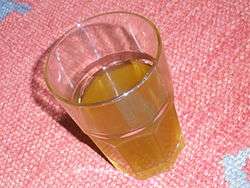Mate cocido
.jpg) | |
| Type | Hot or cold beverage |
|---|---|
| Country of origin | Paraguay |
| Introduced | 17th century[1] |
Mate cocido (Spanish pronunciation: [ˈmate koˈsiðo], boiled mate; Portuguese: chá mate, IPA: [ˈʃa ˈmati], mate tea; Guarani: kojoi, IPA: [koˈɟoi] ) (or just cocido like in Corrientes Province) is an infusion typical of Southern Cone cuisine (mostly consumed in Southern Brazil, Argentina, Paraguay and Uruguay). It is traditionally prepared by boiling yerba mate in water, then strained and served in cups. It is a bitter tasting beverage, similar to mate but milder, with the same stimulating and nutritional properties. It is also sold in tea-bags, so it can be prepared like tea.
History

The Jesuits in the current territories of the south of Brazil and Paraguay, and the Argentine provinces of Misiones and Corrientes, in the first decades of the 17th century improved the cultivation technique of the yerba mate and exported it. Spain, to compete with the tea that England sold, put a chopped yerba maté on sale to make tea that became popular in Europe, known as the "Tea of the Jesuits".[1]
That "Tea of the Jesuits" from the 17th century, today has become the mate cocido, a very popular infusion that, because of the low price of yerba mate compared to the price of tea or coffee, has become since the early 20th century the common beverage in schools, hospitals and prisons.[1]
Elaboration
The elaboration of mate cocido in tea-bags is almost the same than regular yerba mate, with the difference that in the grinding the dust and sticks are removed, sorting and processing only the leaves.[2] The mate cocido is also produced in soluble form.[3]
Varieties
- Traditional: made from yerba mate, sometimes consumed with milk and sweetened.[3]
- Flavored: mate cocido to which an additional flavor has been applied. Some flavors are lemon, peach, vanilla, orange and tangerine.[2][3]
- Iced mate cocido: also called "cold mate cocido". It is a highly refreshing drink, the traditional or flavored mate cocido served cold, usually adding ice and lemon juice.[3]
See also
References
- 1 2 3 "El té de los Jesuitas (historia de la yerba maté)" (in Spanish). Miguel Krebs. Retrieved 2010-12-14.
- 1 2 "Establecimiento Las Marías - Elaboración del mate cocido" (in Spanish). Lasmarias.com.ar. Retrieved 2012-02-06.
- 1 2 3 4 "Yerba Mate Amanda - Mate cocido/té" (in Spanish). Yerbamanda.com.ar. Retrieved 2012-02-06.